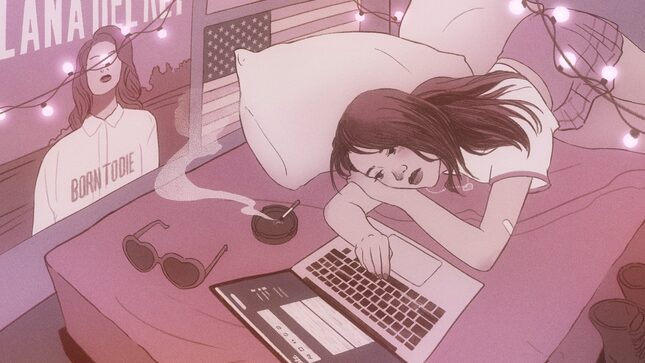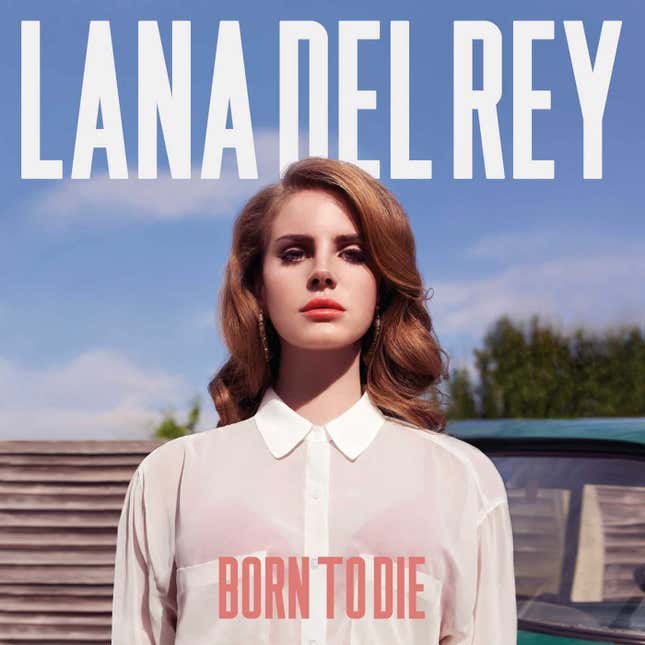Lana Del Rey and the Allure of Aestheticized Pain
With Born to Die, Tumblr became awash in soft-grunge imagery that romanticized self-harm and dissatisfied femininity. Some yearn for it today.
In DepthIn Depth
Illustration: Angelica Alzona
This story includes themes of self-harm, disordered eating, and nonconsensual sexual relationships.
It’s this time ten years ago, and my best friend Rachael is dancing at herself in her bedroom mirror. She is swaying to a suite of songs, caressing everywhere except her panty line. She is totally withdrawing into her own fantasy world. Lana Del Rey always turns her this way, I think, trying to muffle my curiosity with revulsion. (I’m a 17-year-old lesbian who, at this point, absolutely cannot understand Lana’s appeal.) She is singing things like “my old man is a bad man” and “it’s you, it’s you, it’s all for you” as she pouts her lips and grabs at her own throat. She is lost in the cinematography of her own desires.
Born To Die, Lana’s second studio album, has just been released. It is an album full of self-destruction and willful submission, hellbent on a one-way death drive toward libidinal excess. It is also an album made by a recovering addict, one who hasn’t had a drink for nine years and is clearly nostalgic for the giddiness of mania. Lana lives out her alcoholism, addiction, and destructive tendencies through her art, populating the world of Born To Die with unsustainable fantasies: American maximalism, sadomasochism, too much liquor, older men, shitty men, unavailable men, Vladimir Nabokov’s Lolita, money—as well as disappointment when those fantasies neither last nor materialize into real life. You can hear that tension in the music as she sings with a bored disaffection over soaring instrumentation.
With the album on repeat in the background, Rachael spends most of her days and nights on Tumblr, showing up to class wired on a dream-filled two-hour sleep. She often reblogs kink, sugarbaby, and nymphet content, as well as some images of self-harm and pro-ana (pro-anorexia). Lana plays a central role in each of these online communities, as they herald her as one of their own. Her love for daddies and older men (“I got sweet taste for men who are older,” she sings on “Cola”), her resistance to self-improvement (“I don’t wanna know what’s good for me,” she sings on “Gods & Monsters”), her mostly buried but nonetheless risqué lyrics on eating disorder culture (“I’m a fan of pro-ana nation/I do them drugs to stop the f-food cravings,” she sings on an old track called “Boarding School”)—not to mention her perfectly tacky glamor and hip-hop-meets-Old Hollywood high femme look—represent a new kind of dissatisfied femininity that is spread throughout Tumblr.

Ten years ago, the music Rachael danced to seemed to function like a Tumblr dashboard itself, Lana’s lyrics largely made up of petrified, recurring images: the American flag, Marilyn Monroe, gold coins, blue jeans, cognac, heart-shaped sunglasses. On entering that world, one’s emotions heightened, becoming fodder for an easily mimicked and coherent aesthetic on Tumblr known as “soft grunge.” Often filtered through pastel colors, soft grunge both beautified and subdued pain, making it consumable and even aspirational. Most of the images under the soft grunge rubric channeled illness, pain, and harm through a faded light, combining the cute with the abject. Parma violet-colored pills. Scars the shade of weakly drawn lines of water color. Bruises around throats where a hand had been, tones of twisted marshmallows. Lana in gif form with a pastel-colored flower crown on her head repeating the words “I wish I was dead.”
Now, a decade later, we seem to be living through peak Tumblr nostalgia, as the aesthetically symbiotic worlds between Lana and soft grunge Tumblr are being reimagined by Tiktokers and Girlbloggers. For many of the young women who spent their after-school hours online, trying to fantasize their way out of the mundanity of their teenage bedrooms, lockdown inspired a revisitation and a reckoning. Some grapple with the problematic context in which the Lana-Tumblr moment existed, where thinness was treated like divinity and self-harm brought in reblogs and engagement. Some yearn to return to it.
“I do vividly remember that after I started listening to Lana, the content I would reblog would be a more sensual, erotic BDSM, Lolita, soft blush pink sort of aesthetic,” Taylor (who, like most of sources in this story, goes by her forename to protect her identity) told me. She was part of Tumblr’s nymphet community a decade ago, while a sophomore in college. So too was Anna (a pseudonym), who says that while she ran a daddy-worshipping blog that she hid from her friends, self-harm was the only original content she ever posted on Tumblr in her young teens. She also was “guilty of browsing through [pro-ana] tags to try to find tips to lose weight quickly.” Her blogs, adorned with Lana Del Rey lyrics, were largely a form of escapism. “I used them as (unhealthy) coping mechanisms for past trauma and the mental health issues I was dealing with at the time,” she told me.
Since its 2007 beginnings, Tumblr has been a popular hub for blogs about self-harm, as well as disordered eating and suicidal ideation. It gave rise to a deeply confessional and earnest emotional register, possibly because the website felt so much like an enclave, a hidden corner of the internet where most users remained totally anonymous, finding community with others who shared a similar aesthetic and disaffection with life itself. Jenna, who was in Tumblr’s nymphet and pro-ana communities (a common overlap), told me, “For some people, you need to start off making sad posts to learn how to make friends online; it’s instant community.” Taylor wanted both that sense of community, as well as “a more romantic, indulgent life.” She found it in the nexus of Lana Del Rey-touting Tumblr blogs.
-

-

-

-

-

-

-

-

-

-

-

-

-

-

-

-

-

-

-

-

-

-

-

-

-

-

-

-

-

-

-

-

-

-

-

-

-

-

-

-








































